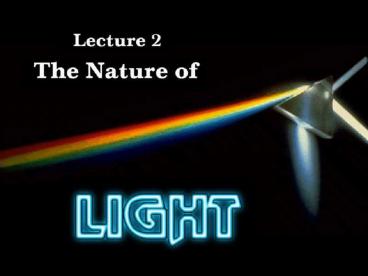Lecture 2 The Nature of Light - PowerPoint PPT Presentation
1 / 27
Title:
Lecture 2 The Nature of Light
Description:
Lecture 2 The Nature of Light. Why does a compass needle always point to ... which boat would return to B first? Similarly, use a Michelson Interferometer to ... – PowerPoint PPT presentation
Number of Views:198
Avg rating:3.0/5.0
Title: Lecture 2 The Nature of Light
1
Lecture 2 The Nature of Light
2
Action at a Distance
Why does a compass needle always point tothe
north pole, without anything moving it?
3
Faraday realised that ...
Michael Faraday (1791-1867)
A magnet has a magnetic field distributed
throughout the surrounding space
4
Photo of magnet with iron filings
5
Although two magnets may not be touching, they
still interact through their magnetic fields.
This explains the action at a distance, of
say a compass.
6
Similarly, Faraday realised that the electric
force is transmitted by a electric field
7
Question
Now, what is the medium through which
theelectric and magnetic fields are transmitted?
Answer vacuum?
8
Recall that sound waves ...
are transmitted through air via pressure
vibrations
9
These vibrations eventually reach our ears and
cause them to vibrate.
This is how we hear sounds.
10
In general ...
A wave is a vibration of some mediumthrough
which it propagates, e.g., waterwaves, waves
propagating on a string
11
So ...
- How are electric and magnetic fields transmitted
through a vacuum? - A vacuum, by definition, does not have anything
in it - So what does the vibrating in this case?
12
Maxwell hypothesised that ...
- All of space was filled with a substance called
luminiferous aether - Electric and magnetic fields are distortions
or twists of the aether
James Clerk Maxwell (1831-1879)
13
Maxwell also discovered his famous equations
14
Two implications of Maxwells equations
- Light consists of an oscillating electric and
magnetic field
- Light travels at constant speed
15
The Electromagnetic SpectrumEvidence for the
wave nature of light
16
What is this speed c measured with respect to?
With respect to the aether, naturally!?
17
Roemers First Measurement of c (1676)
- Used eclipses of Jupiter and its moons
- Observations made at position A enabled
astronomers to predict when eclipses would occur - But at position B six months later,eclipses
occurred 22 minutes laterthan predicted - Roemer realised from this resultthat sight is
not instantaneous,i.e., light has a finite
speed
18
Measurements of the speed of light
Today c is defined to be exactly 299,792,458 m/s,
and this is used to define the metre
19
Animation of Earth and Sun moving through the
hypothetical aether
20
The Michelson-Morley Experiment (1887)
Albert Michelson (1852-1931)became the first
American towin the Nobel Prize in 1907
Search is on for the aether ...
21
Imagine measuring the speed of a river
If distances AB and BC are the same,which boat
would return to B first?
22
Similarly, use a Michelson Interferometer to ...
23
... measure the speed of Earth moving through the
aether
Interference patterns in this setup were expected
to form in such a way that one could determine
the speed of Earth relative to the hypothetical
aether
24
Rotating the apparatus would give the direction
of the aether drift
25
But ...
- No aether drift was detected whatsoever,despite
repeated experiments! - Appears that Earth is not moving with respect to
the aether - Is Earth really at the centre of the universe?
Is Earth at the centre of an aetheral cyclone?
26
Lorentz-Fitzgerald Contraction Hypothesis
The entire apparatus had shrunk in the direction
of Earths motion through the aether! (Turns out
there is some truth in this, as we shall see in
the next lecture)
27
Einsteins dramatic explanation
- There is no such thing as luminiferous aether
- The speed of light is the same (constant) in any
direction, which explains the null results of MM - Although we have come one big circle, this
realisation of Einstein paved the way for his
theory of relativity

